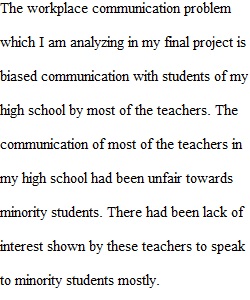


Q Participation in this learning activity is worth 2.5% if your final grade. For this exercise, you will tell your classmates what you learned about the communication theory you researched and why you think it’s the right one for your final project. You should be able to use the material that you develop here in your final project. Before you tackle this exercise, please make sure you have read the Week 3 course materials. (*Remember, if you are not employed or cannot discuss your workplace, you should be using a communication problem from another organizational setting in which you are involved for your final project, such as school, church, or a community group.) Objective: This activity is designed to help you synthesize and begin applying what you are learning to your final project. You should be able to use material from your response to help you develop the research question for your final project. Background: Please begin this exercise by reading the following information carefully. Activity: Answer the following questions. 1. What is the workplace* communication problem that you’re analyzing in your final project? Briefly describe it. 2. What is the name of the communication theory that you think applies to your workplace communication problem and what is its goal (to predict, explain, change, or understand a phenomenon)? 3. To which of the seven communication traditions does this theory’s field of study belong? Explain the tradition and why this theory belongs in that category. 4. Which of the communication contexts does the theory address? Explain the context and why this theory belongs in that category. 5. Does the theory seek to answer questions of ontology, epistemology, or axiology about the nature of reality? Define the term as part of your answer. 6. In your own words, summarize your theory. Make sure to include an explanation of its assumptions (primary axioms). 7. What kinds of communication problems can this theory be used to investigate? Explain and provide examples that will show us why this theory is relevant to your workplace communication problem. Make sure to connect your ideas to course content, using American Psychological Association-style references. If you are unfamiliar with that reference style, you can find examples at the following link: http://sites.umgc.edu/library/libhow/apa_examples.cfm Due Dates: Please post your initial response to this prompt by 11:59 p.m. Eastern Time on <Saturday>. You will not see any of your classmates’ posts until you post your own. Once you have replied, please help your classmates here to develop their ideas by sharing your knowledge, expertise, and resources on their topics. Post at least two substantive comments on your classmates’ exercises by 11:59 p.m. Eastern Time on Tuesday. You also will be working on Discussion 3.2 this week. ©2020 University of Maryland Global Campus
View Related Questions